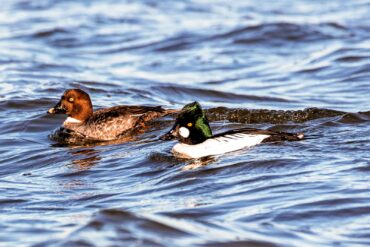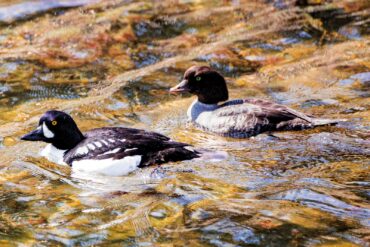
For Pacific Northwest birders, winter means ducks. After breeding in the Arctic, myriads of ducks enjoy wintering in Western Washington on water that isn’t frozen. About two dozen species of ducks regularly visit West Sound waters each winter.
Ducks come in many varieties and are often named according to their physical description. For example, long-tailed ducks have long tails, ring-necked ducks have ringed necks and ruddy ducks are rusty red. So it comes as no surprise that a pair of ducks called “goldeneyes” actually have golden eyes.
From fall to spring, the common goldeneye and Barrow’s goldeneye live in West Sound waters, loosely associating with mixed flocks of ducks on local bays, estuaries, lakes and streams.
As the name suggests, the common goldeneye has a widespread range. It breeds across the boreal forests of Canada, Alaska, Russia and Scandinavia. It winters in the United Kingdom and parts of Europe, as well as China and Japan. North American common goldeneyes winter throughout much of the United States.
The Barrow’s goldeneye is named for Sir John Barrow (1764-1848), a British official who promoted Arctic exploration. Once referred to as the Rocky Mountain goldeneye, it has a breeding range that’s mainly limited to the montane regions west of the Continental Divide, from Alaska to California and Utah.
Barrow’s goldeneyes primarily winter in estuaries and bays along the Pacific Coast, with some scattering themselves among lakes throughout the West. Small populations reside in the northeastern Canadian provinces and Iceland.

Males are distinctive, especially from close range. The common goldeneye sports a striking green head in direct sunlight, with a trademark white dot on the cheek. Its back is black and its sides are mostly white.
The Barrow’s goldeneye has a dark head that looks black in the shade, but shines an iridescent dark purple in direct light. It’s easy to distinguish from its more common cousin by a white teardrop on the cheek and distinctive white spots along its back.
With their brown heads, female goldeneyes are more difficult to differentiate, especially from a distance. From close range, you can notice the yellow-tipped black bill of the common goldeneye and the black-tipped yellow-orange bill of the Barrow’s goldeneye.
Goldeneyes are strong fliers, capable of cruising at 40 mph. Common goldeneyes are known for their fast takeoffs, getting airborne after running on the water for just a few steps. Barrow’s goldeneyes use a longer runway of several meters when taking flight.
Goldeneyes are diving ducks, foraging in shallow water close to shore. They primarily feed on aquatic invertebrates, including crustaceans, mollusks, dragonflies, insect larvae, fish eggs and small amounts of vegetation such as pondweed. The common goldeneye prefers to forage in lakes without fish, so there’s less competition for food.
The common goldeneye is aggressive, outcompeting other ducks for preferred feeding areas. Not to be pushed around by its cousin, the Barrow’s goldeneye is the only waterfowl species to sometimes become territorially defensive in winter. It’s more tolerant of dabbling ducks than other diving ducks.
Common and Barrow’s goldeneye drakes are both known for their elaborate courtship displays of head throws and leg kicks, which they perform in small groups in winter. When a female is won over, she responds with her own head swings and establishes the bond with her new mate. Monogamous pairs form by early spring.
Both the common and Barrow’s goldeneye are cavity nesters. Incapable of creating their own nest sites, they primarily utilize nest chambers previously dug out by pileated woodpeckers. Pairs often return to the same nest for multiple consecutive years. Goldeneyes also use nest boxes with wood shavings in the bottom, which simulates the floor of a natural cavity.
Clutch size for the common goldeneye is four to nine eggs. The Barrow’s goldeneye lays a few more, usually six to 12. Hybridization between the two species is rare.
Fledgling goldeneyes leave the nest within a couple of days. Following their mother’s call, the chicks leap from the nest, which may be 40 feet high, bouncing harmlessly off the leaf litter for their welcome into the world. They then follow their mother to the nearest water. In some cases, she abandons the chicks, which can feed themselves and join with another brood for protection.
Common goldeneye populations appear to be stable, but Barrow’s goldeneye numbers are more difficult to determine due to the more remote breeding range. Most studies show that the Barrow’s goldeneye may be in decline. Both species are susceptible to breeding habitat degradation due to the removal of dead trees, which are essential for providing nesting cavities. Marine pollutants and potential oil spills along shorelines are constant threats to survival.
Ducks may look the same from a distance, but each species is unique and fun to watch. Common and Barrow’s goldeneyes make West Sound winters a little more golden.

























